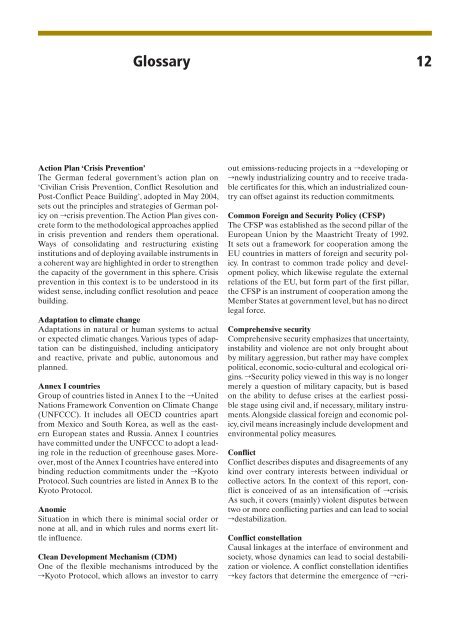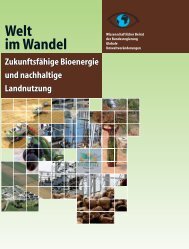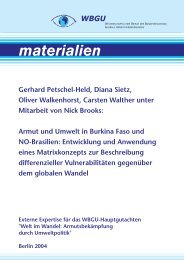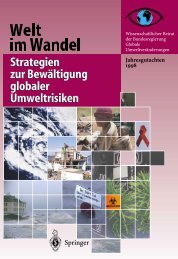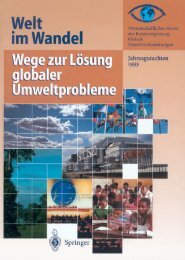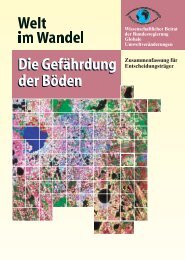World in Transition: Climate Change as a Security Risk - WBGU
World in Transition: Climate Change as a Security Risk - WBGU
World in Transition: Climate Change as a Security Risk - WBGU
Create successful ePaper yourself
Turn your PDF publications into a flip-book with our unique Google optimized e-Paper software.
Action Plan ‘Crisis Prevention’<br />
The German federal government’s action plan on<br />
‘Civilian Crisis Prevention, Conflict Resolution and<br />
Post-Conflict Peace Build<strong>in</strong>g’, adopted <strong>in</strong> May 2004,<br />
sets out the pr<strong>in</strong>ciples and strategies of German policy<br />
on ’crisis prevention. The Action Plan gives concrete<br />
form to the methodological approaches applied<br />
<strong>in</strong> crisis prevention and renders them operational.<br />
Ways of consolidat<strong>in</strong>g and restructur<strong>in</strong>g exist<strong>in</strong>g<br />
<strong>in</strong>stitutions and of deploy<strong>in</strong>g available <strong>in</strong>struments <strong>in</strong><br />
a coherent way are highlighted <strong>in</strong> order to strengthen<br />
the capacity of the government <strong>in</strong> this sphere. Crisis<br />
prevention <strong>in</strong> this context is to be understood <strong>in</strong> its<br />
widest sense, <strong>in</strong>clud<strong>in</strong>g conflict resolution and peace<br />
build<strong>in</strong>g.<br />
Adaptation to climate change<br />
Adaptations <strong>in</strong> natural or human systems to actual<br />
or expected climatic changes. Various types of adaptation<br />
can be dist<strong>in</strong>guished, <strong>in</strong>clud<strong>in</strong>g anticipatory<br />
and reactive, private and public, autonomous and<br />
planned.<br />
Annex I countries<br />
Group of countries listed <strong>in</strong> Annex I to the ’United<br />
Nations Framework Convention on <strong>Climate</strong> <strong>Change</strong><br />
(UNFCCC). It <strong>in</strong>cludes all OECD countries apart<br />
from Mexico and South Korea, <strong>as</strong> well <strong>as</strong> the e<strong>as</strong>tern<br />
European states and Russia. Annex I countries<br />
have committed under the UNFCCC to adopt a lead<strong>in</strong>g<br />
role <strong>in</strong> the reduction of greenhouse g<strong>as</strong>es. Moreover,<br />
most of the Annex I countries have entered <strong>in</strong>to<br />
b<strong>in</strong>d<strong>in</strong>g reduction commitments under the ’Kyoto<br />
Protocol. Such countries are listed <strong>in</strong> Annex B to the<br />
Kyoto Protocol.<br />
Anomie<br />
Situation <strong>in</strong> which there is m<strong>in</strong>imal social order or<br />
none at all, and <strong>in</strong> which rules and norms exert little<br />
<strong>in</strong>fluence.<br />
Clean Development Mechanism (CDM)<br />
One of the flexible mechanisms <strong>in</strong>troduced by the<br />
’Kyoto Protocol, which allows an <strong>in</strong>vestor to carry<br />
Glossary 12<br />
out emissions-reduc<strong>in</strong>g projects <strong>in</strong> a ’develop<strong>in</strong>g or<br />
’newly <strong>in</strong>dustrializ<strong>in</strong>g country and to receive tradable<br />
certificates for this, which an <strong>in</strong>dustrialized country<br />
can offset aga<strong>in</strong>st its reduction commitments.<br />
Common Foreign and <strong>Security</strong> Policy (CFSP)<br />
The CFSP w<strong>as</strong> established <strong>as</strong> the second pillar of the<br />
European Union by the Ma<strong>as</strong>tricht Treaty of 1992.<br />
It sets out a framework for cooperation among the<br />
EU countries <strong>in</strong> matters of foreign and security policy.<br />
In contr<strong>as</strong>t to common trade policy and development<br />
policy, which likewise regulate the external<br />
relations of the EU, but form part of the first pillar,<br />
the CFSP is an <strong>in</strong>strument of cooperation among the<br />
Member States at government level, but h<strong>as</strong> no direct<br />
legal force.<br />
Comprehensive security<br />
Comprehensive security emph<strong>as</strong>izes that uncerta<strong>in</strong>ty,<br />
<strong>in</strong>stability and violence are not only brought about<br />
by military aggression, but rather may have complex<br />
political, economic, socio-cultural and ecological orig<strong>in</strong>s.<br />
’<strong>Security</strong> policy viewed <strong>in</strong> this way is no longer<br />
merely a question of military capacity, but is b<strong>as</strong>ed<br />
on the ability to defuse crises at the earliest possible<br />
stage us<strong>in</strong>g civil and, if necessary, military <strong>in</strong>struments.<br />
Alongside cl<strong>as</strong>sical foreign and economic policy,<br />
civil means <strong>in</strong>cre<strong>as</strong><strong>in</strong>gly <strong>in</strong>clude development and<br />
environmental policy me<strong>as</strong>ures.<br />
Conflict<br />
Conflict describes disputes and disagreements of any<br />
k<strong>in</strong>d over contrary <strong>in</strong>terests between <strong>in</strong>dividual or<br />
collective actors. In the context of this report, conflict<br />
is conceived of <strong>as</strong> an <strong>in</strong>tensification of ’crisis.<br />
As such, it covers (ma<strong>in</strong>ly) violent disputes between<br />
two or more conflict<strong>in</strong>g parties and can lead to social<br />
’destabilization.<br />
Conflict constellation<br />
Causal l<strong>in</strong>kages at the <strong>in</strong>terface of environment and<br />
society, whose dynamics can lead to social destabilization<br />
or violence. A conflict constellation identifies<br />
’key factors that determ<strong>in</strong>e the emergence of ’cri-


